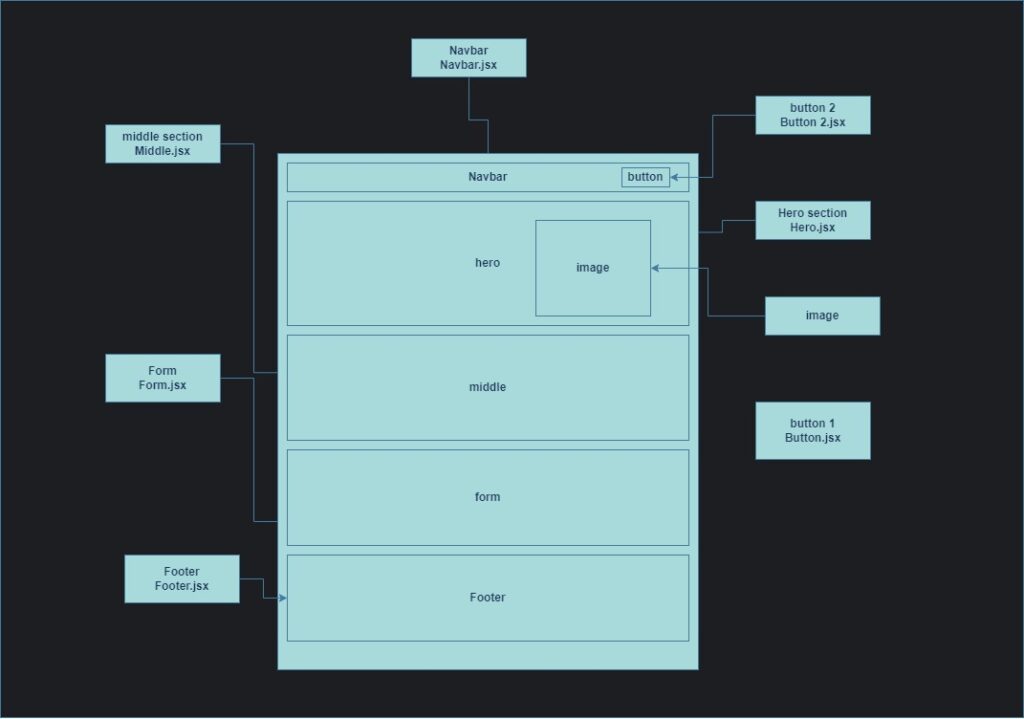Components
React components are independent and reusable block of code which returns React elements and help to create a user interface (UI).

- Every part of a React application is a component, which splits the UI into independent reusable code.
- Each independent section is processes separately.
- We can easily update or change any component of an application without disturbing the rest of the application.
Components lifecycle
In React, components have a lifecycle — a set of methods and events that occur from the moment a component is created to the moment it is removed from the DOM. The lifecycle of components differs slightly between Class Components and Functional Components, especially with the introduction of Hooks.
Class Components Lifecycle
Class components in React have a set of built-in methods that you can override to run code at different points during the component’s lifecycle. These methods are grouped into three main phases: Mounting, Updating, and Unmounting.
1. Mounting (When a component is being created and inserted into the DOM):
constructor(): Runs when the component is created. It’s typically used to initialize state and bind event handlers.static getDerivedStateFromProps(): Called before every render, both on the initial mount and when new props are received. This is used for updating the state based on changes in props.render(): Required method that returns the JSX (orReact.createElement) that represents the UI.componentDidMount(): Called once the component is mounted (added to the DOM). It’s useful for fetching data or starting timers.
2. Updating (When a component is being re-rendered due to changes in state or props):
static getDerivedStateFromProps(): Called again before every render, when either the state or props change.shouldComponentUpdate(): Allows you to optimize performance by deciding whether the component should re-render based on changes in state or props. By default, it returnstrue.render(): Called again to update the UI.getSnapshotBeforeUpdate(): Called right before the changes from the render are applied to the DOM. It can be used to capture information (like scroll position) before the DOM is updated.componentDidUpdate(): Called after the component updates in the DOM. It receives previous props and state as arguments.
3. Unmounting (When a component is being removed from the DOM):
componentWillUnmount(): Called just before the component is removed from the DOM. It’s used for cleanup, like canceling network requests or clearing timers.
Functional Components Lifecycle with Hooks
Functional components, since React 16.8, can now handle lifecycle events using Hooks. The useEffect hook replaces many of the class component lifecycle methods and allows you to perform side effects in functional components.
1. Mounting (When a component is first added to the DOM):
useEffect(() => {...}, []): This is similar tocomponentDidMount()in class components. It runs once after the component mounts. The empty array[]ensures the effect only runs once.jsxuseEffect(() => { // Code here runs once when the component mounts }, []);
2. Updating (When a component re-renders due to state or props changes):
useEffect(() => {...}, [dependencies]): This is likecomponentDidUpdate(). The code inside this hook runs after every render if any value in the dependency array changes. If you provide a list of dependencies, React will run the effect only when those dependencies change.jsxuseEffect(() => { // Code here runs when a specific prop or state value changes }, [someValue]); // Only runs when `someValue` changes
3. Unmounting (When a component is removed from the DOM):
useEffect(() => { return () => {...} }, []): This is similar tocomponentWillUnmount()in class components. The return function is the cleanup function, which is executed when the component is unmounted or when the dependencies change.jsxuseEffect(() => { // Code here runs when the component mounts return () => { // Code here runs when the component unmounts }; }, []);
Complete Lifecycle Map
| Class Component | Functional Component (with Hooks) |
|---|---|
constructor() | Not needed (initialization in body) |
static getDerivedStateFromProps() | useEffect() (with empty dependency array for first mount) |
render() | Direct return of JSX (no render method) |
componentDidMount() | useEffect(() => {...}, []) |
shouldComponentUpdate() | React automatically re-renders, but you can optimize using React.memo |
static getDerivedStateFromProps() | useEffect() with specific dependencies |
getSnapshotBeforeUpdate() | useEffect() can also return a cleanup function (though no direct equivalent) |
componentDidUpdate() | useEffect() with dependencies (similar to componentDidUpdate) |
componentWillUnmount() | useEffect() cleanup function |
Types of components
These are the traditional way of defining components in React. They extend from React.Component and typically use a render() method to return JSX.
Example:
import React, { Component } from 'react';
class Welcome extends Component {
render() {
return <h1>Hello, world!</h1>;
}
}
export default Welcome;In this example:
Welcomeis a class component.- It has a
render()method, which returns JSX.
These are simpler components written as JavaScript functions. They receive props as an argument and return JSX.
Example:
jsximport React from 'react'; function Welcome(props) { return <h1>Hello, world!</h1>; }orconst Welcome = ()=>{return(<><h1> Hello world </h1></>)}export default Welcome;
In this example:
Welcomeis a functional component.
Difference between class and function component
1. Syntax
Class Components:
Class components are ES6 classes that extend React.Component. They require a render() method that returns JSX.
import React, { Component } from 'react';
class MyComponent extends Component { render() { return <h1>Hello, World!</h1>; } } export default MyComponent;
Function Components:
Function components are simpler JavaScript functions that return JSX directly. They do not require a render() method.
jsximport React from 'react';
function MyComponent() { return <h1>Hello, World!</h1>; } export default MyComponent;
2. State Management
Class Components:
Class components can manage state using this.state and update it using this.setState().
jsxclass Counter extends React.Component {
constructor(props) { super(props); this.state = { count: 0 }; } increment = () => { this.setState({ count: this.state.count + 1 }); }; render() { return ( <div> <p>Count: {this.state.count}</p> <button onClick={this.increment}>Increment</button> </div> ); } }
Function Components:
Function components use Hooks (specifically, useState) to manage state.
jsx
import React, { useState } from 'react';
function Counter() { const [count, setCount] = useState(0); return ( <div> <p>Count: {count}</p> <button onClick={() => setCount(count + 1)}>Increment</button> </div> ); }
3. Lifecycle Methods
Class Components:
Class components have lifecycle methods like componentDidMount(), componentDidUpdate(), and componentWillUnmount(), which are used to manage side effects and interactions with the DOM.
jsx
class MyComponent extends React.Component {
componentDidMount() { console.log('Component mounted'); } componentDidUpdate(prevProps, prevState) { console.log('Component updated'); } componentWillUnmount() { console.log('Component will unmount'); } render() { return <h1>Hello, World!</h1>; } }
Function Components:
Function components use the useEffect Hook to manage side effects and simulate lifecycle behavior. The effect runs after the component mounts, updates, and unmounts.
jsx
import React, { useEffect } from 'react';
function MyComponent() {
useEffect(() => { console.log('Component mounted'); return () => { console.log('Component will unmount'); }; }, []); // Empty dependency array makes it run only on mount and unmount return <h1>Hello, World!</h1>; }
4. Performance and Optimization
Class Components:
- Class components can be optimized using
shouldComponentUpdate()to control re-rendering. - If not optimized, class components might re-render unnecessarily on state or prop changes.
jsx
class MyComponent extends React.Component {
shouldComponentUpdate(nextProps, nextState) { return nextState.count !== this.state.count; } }
Function Components:
- Function components can be optimized using
React.memo(), which prevents unnecessary re-renders if the props haven’t changed. - State updates in function components trigger re-renders by default, but can be fine-tuned with hooks like
useCallback()anduseMemo().
jsx
const MyComponent = React.memo(function MyComponent(props) {
return <h1>{props.text}</h1>; });
5. Hooks
Class Components:
Class components do not use hooks. They rely on lifecycle methods, state, and other built-in React features.
Function Components:
Function components use hooks (like useState, useEffect, useContext, etc.) to handle state, side effects, and other features that class components use lifecycle methods for.
jsx
import React, { useState, useEffect } from 'react';
function MyComponent() { const [count, setCount] = useState(0); useEffect(() => { console.log('Component mounted or updated'); }, [count]); // Runs on mount or when `count` changes return ( <div> <p>Count: {count}</p> <button onClick={() => setCount(count + 1)}>Increment</button> </div> ); }
6. Code Simplicity
Class Components:
Class components generally require more boilerplate code, especially for managing state and lifecycle methods.
jsx
class MyComponent extends React.Component { constructor(props) { super(props); this.state = { count: 0 }; } increment = () => { this.setState({ count: this.state.count + 1 }); }; render() { return ( <div> <p>Count: {this.state.count}</p> <button onClick={this.increment}>Increment</button> </div> ); } }
Function Components:
Function components are shorter and simpler, especially with hooks. There is no need for constructors, lifecycle methods, or class syntax.
import React, { useState } from 'react';
function MyComponent() { const [count, setCount] = useState(0); return ( <div> <p>Count: {count}</p> <button onClick={() => setCount(count + 1)}>Increment</button> </div> ); }
7. Ref Handling
Class Components:
In class components, you use React.createRef() to create a ref and attach it to a DOM element or component.
jsx
class MyComponent extends React.Component { constructor(props) { super(props); this.myInput = React.createRef(); } focusInput = () => { this.myInput.current.focus(); }; render() { return ( <div> <input ref={this.myInput} /> <button onClick={this.focusInput}>Focus Input</button> </div> ); } }
Function Components:
In function components, you use the useRef() hook to create a ref and attach it to a DOM element.
jsx
import React, { useRef } from 'react'; function MyComponent() { const myInput = useRef(); const focusInput = () => { myInput.current.focus(); }; return ( <div> <input ref={myInput} /> <button onClick={focusInput}>Focus Input</button> </div> ); }
Summary of Differences
| Feature | Class Components | Function Components |
|---|---|---|
| Syntax | ES6 class with render() method |
Function with direct return of JSX |
| State | Uses this.state and this.setState() |
Uses useState() hook |
| Lifecycle Methods | Uses lifecycle methods like componentDidMount(), componentDidUpdate() |
Uses useEffect() hook for lifecycle handling |
| Performance Optimization | Can use shouldComponentUpdate() for optimization |
Can use React.memo() and hooks like useCallback() |
| Hooks | Cannot use hooks | Can use hooks like useState, useEffect, useContext, etc. |
| Code Simplicity | More boilerplate (e.g., constructors, bindings, methods) | Simpler and more concise, especially with hooks |
| Ref Handling | Uses React.createRef() |
Uses useRef() hook |
Conclusion:
- Class components are traditional React components that rely on
stateand lifecycle methods to manage state, effects, and updates. - Function components, especially with the advent of Hooks (
useState,useEffect, etc.), are now the preferred way to write React components due to their simplicity, less boilerplate, and powerful state management and side effect handling.
In modern React development, function components are favored because they provide a cleaner and more concise approach to writing components.
